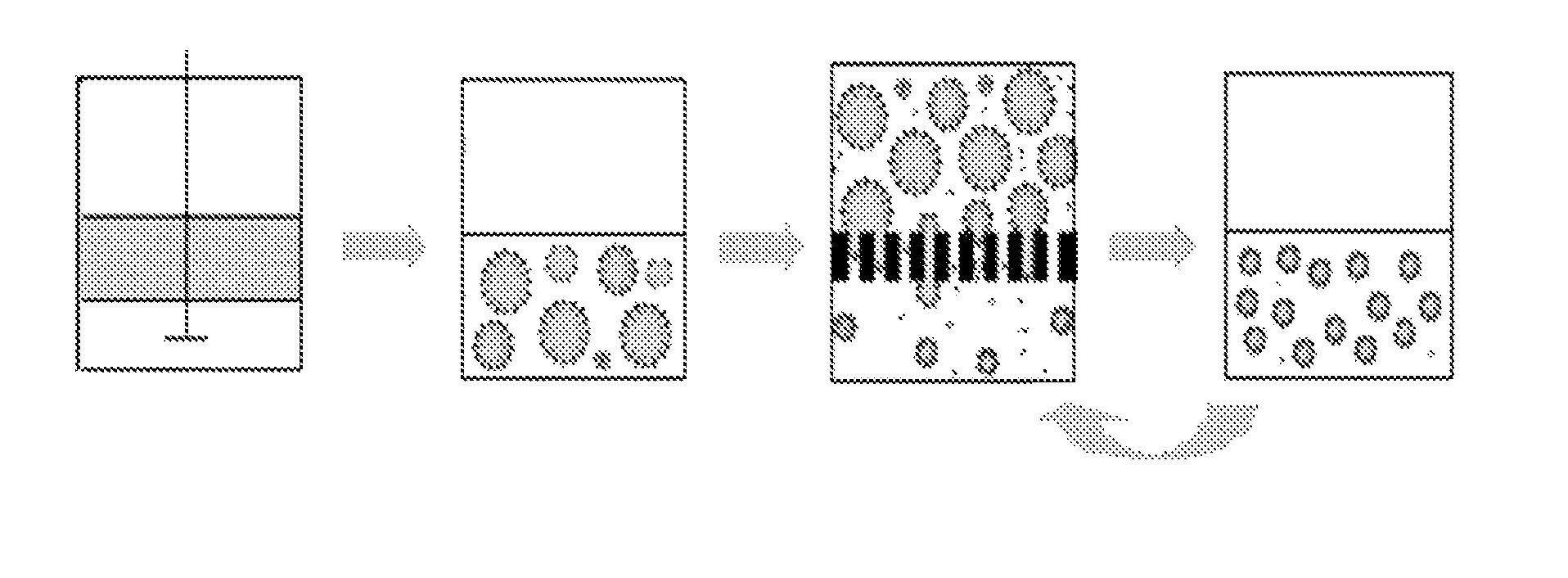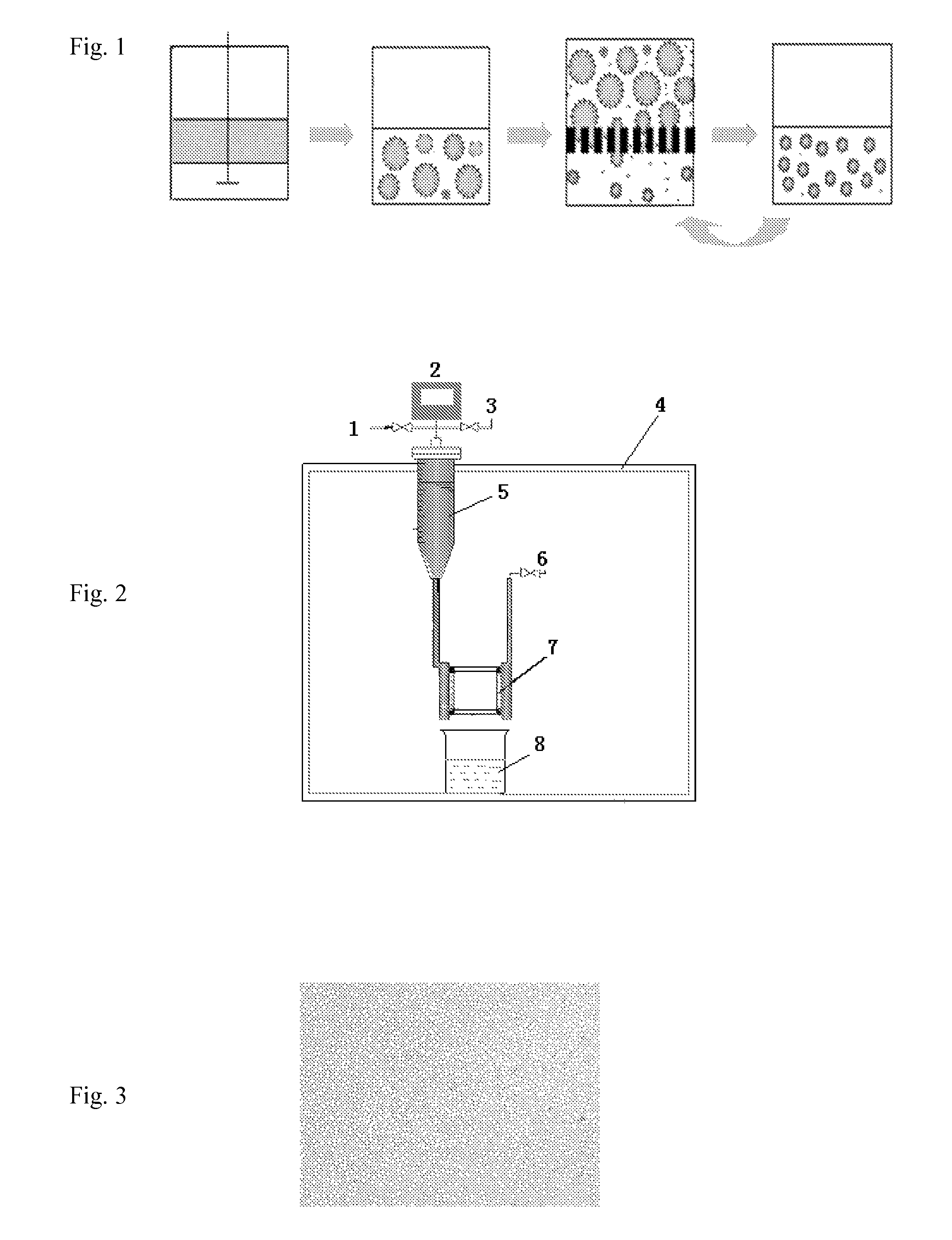Preparation of polysaccharide beads
a technology of polysaccharide and beads, which is applied in the field of preparation of polysaccharide beads, can solve the problems of uneven particle size of emulsion, particle size of liquid droplets cannot be controlled, uneven particle size of beads,
- Summary
- Abstract
- Description
- Claims
- Application Information
AI Technical Summary
Benefits of technology
Problems solved by technology
Method used
Image
Examples
example 1
[0066]The hydrophobic membrane with pore diameter of 10.2 μm is soaked in lipophilic substance in order to fully wet porous membrane and thoroughly stretch hydrophobic chains on the membrane. The agarose and NaCl are correctly weighed to water to assure agarose concentration of 10 wt %, and NaCl concentration of 0.9 wt %. They are heated and fully dissolved in water to form a solution, which is kept below 65° C. The oil-soluble emulsifier PO-500 is added to 16 ml of liquid paraffin and petroleum ether mixture (volume ratio of 7:5) to assure the concentration of 4 wt %, stirred until they are thoroughly dissolved to form the mixture used as the oil phase, and heated to 65° C. Under heating, about 4 g of water phase and oil phase are mixed and homogenized and emulsified for 30 seconds at 6000 rpm, and then the obtained emulsion is quickly transferred to the membrane emulsification setup preheated to 65° C. and quickly passed through the hydrophobic microporous membrane with uniform po...
example 2
[0071]The hydrophobic membrane with pore diameter of 5.7 μm is soaked in lipophilic substance in order to fully wet porous membrane and thoroughly stretch hydrophobic chains on the membrane. The agarose and NaCl are correctly weighed to water to assure agarose concentration of 10 wt %, and NaCl concentration of 0.9 wt %. They are heated and fully dissolved in water to form a solution, which is kept below 65° C. The oil-soluble emulsifier PO-500 is added to 16 ml of liquid paraffin and petroleum ether mixture (volume ratio of 7:5) to assure the concentration of 4 wt %, stirred until they are thoroughly dissolved to form the mixture used as the oil phase, and heated to 65° C. Under heating, about 4 g of water phase and oil phase are mixed and homogenized and emulsified for 30 seconds at 6000 rpm, and then the obtained emulsion is quickly transferred to the membrane emulsification setup preheated to 65° C. and quickly passed through the hydrophobic microporous membrane with uniform por...
example 3
[0072]The hydrophobic membrane with pore diameter of 15 μm is soaked in lipophilic substance in order to fully wet porous membrane and thoroughly stretch hydrophobic chains on the membrane. The agarose and NaCl are correctly weighed to water to assure agarose concentration of 10 wt %, and NaCl concentration of 0.9 wt %. They are heated and fully dissolved in water to form a solution, which is kept below 65° C. The oil-soluble emulsifier PO-500 is added to 16 ml of liquid paraffin and petroleum ether mixture (volume ratio of 7:5) to assure the concentration of 4 wt %, stirred until they are thoroughly dissolved to form the mixture used as the oil phase, and heated to 65° C. Under heating, about 4 g of water phase and oil phase are mixed and homogenized and emulsified for 30 seconds at 6000 rpm, and then the obtained emulsion is quickly transferred to the membrane emulsification setup preheated to 65° C. and quickly passed through the hydrophobic microporous membrane with uniform pore...
PUM
| Property | Measurement | Unit |
|---|---|---|
| pore diameter | aaaaa | aaaaa |
| pore diameter | aaaaa | aaaaa |
| sizes | aaaaa | aaaaa |
Abstract
Description
Claims
Application Information
 Login to View More
Login to View More - R&D
- Intellectual Property
- Life Sciences
- Materials
- Tech Scout
- Unparalleled Data Quality
- Higher Quality Content
- 60% Fewer Hallucinations
Browse by: Latest US Patents, China's latest patents, Technical Efficacy Thesaurus, Application Domain, Technology Topic, Popular Technical Reports.
© 2025 PatSnap. All rights reserved.Legal|Privacy policy|Modern Slavery Act Transparency Statement|Sitemap|About US| Contact US: help@patsnap.com



